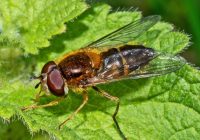Dr Phil Smith’s Wildlife Notes
April 2024
An unusual April – no drought! Rachael Parks tells me there were 19 days with measurable rainfall in Formby, totalling about 55mm, which is around average for the month. Nationally, there was about 55% more rain than usual, including a named storm from 6th to 9th. The latter coincided with very high spring tides (10.2m Liverpool OD), leading to the biggest storm surge here since 2013. Ian Wolfenden sent me lots of photos taken at Hightown in the teeth of the gale. He was soaked to the skin by rain and spray as giant waves attacked the narrow belt of protective sand-dunes. I went the following day to record the damage, including several metres of dunes lost and oak trees falling onto the beach near the Sailing Club. The large northern reedbed had been overtopped and partly flattened. While contemplating the carnage, a familiar call drew my attention to 10 elegant Sandwich Terns migrating north.
The damp conditions, especially early in the month, meant one of the best displays ever of dune annuals – an absolute delight. They included sheets of Sea Mouse-ear and the Early Forget-me-not with its tiny electric-blue flowers. However, the botanical highlight of the month came later, on 26th, when I followed up a report from Steve Cross of two Green-winged Orchids on the grass verge at Thornbeck Avenue, Hightown. Sure enough, there they were, about 7m apart. These verges are already known to support rich plantlife, including the rare Clustered Clover, not yet in flower; the orchids were a real bonus, being recorded, in the region, only from Altcar Training Camp and near Cabin Hill, Formby. John Dempsey kindly arranged for the section of verge holding the orchids to be marked so that Council mowing can be delayed. A few days later, Ian Wolfenden found a third Green-winged Orchid in the Hightown dunes – another extraordinary discovery!
Often adversely affected by dry conditions, the nationally scarce coastal form of Groundsel was prolific this month on the younger dunes near the sea. Mike Wilcox suggests that this plant should be classified as a full species, having many differences from the ordinary Groundsel. Another plant benefiting from the rain was the nationally rare Early Sand-grass which I visit annually on the strip of dunes west of Southport Marine Lake. This tiny grass is intolerant of competition, needing short vegetation and patches of bare ground. There was still plenty of it at the Marine Lake but vegetation overgrowth and scrub invasion are reducing the available habitat. I also went to Ainsdale Local Nature Reserve to check on the bush of Don’s Willow I found in March. Happily, the male catkins confirmed my identification, making this the 37th bush for the Sefton Coast of this incredibly rare hybrid. There are only about four more bushes known in Britain. The same afternoon, Green Sefton staff were rounding up the English Longhorn cattle that grazed the reserve all winter. They have done an excellent job, small duneland flowers flourishing where, a few years ago, they were restricted by tall coarse swards of grass and bramble.
Keen botanist, Robert Freeth, joined me on 22nd to enjoy the spring flowers at Formby Point. As well as reveling in the usual dune annuals, we visited a long-established population of the non-native Corsican Hellebore and a spectacular stand of Primroses. Nearby, we were delighted to find a flowering patch of the uncommon Field Mouse-ear (Red-list Near Threatened in England). I kept an eye open for any interesting insects, finding an unfamiliar spikey black-and-yellow caterpillar. The photo was identified by Richard Walker as the Scarlet Tiger moth, a mainly southern species that has spread north in recent years but is still rare in Sefton.
As usual, a wealth of insects emerged during April. My first Orange Tip butterfly was on 2nd; an equally colourful Comma appeared on 4th while 11th produced the first Speckled Woods. My earliest St. Mark’s Fly was noted on 12th. This common insect is supposed to emerge two weeks later on St. Mark’s Day, 25th April. Whoever named it didn’t take account of climate change. By 20th, calmer weather and sunshine brought out the first Spring Heath Robberflies at Ravenmeols, a real Sefton Coast speciality. Young Sycamore leaves attracted basking hoverflies, including the striking bumblebee mimics, Buff-tailed Bumblefly and Dimorphic Bumblefly. A highlight of one of my walks on the outskirts of Formby was an Ashy Mining-bee, supposedly common, though I rarely see it. This suburban site also had a pair of Hawthorn Shieldbugs in close embrace, several Dock Bugs and up to 16 kinds of hoverfly, including the Common Snout Fly, whose face is extended into a long ‘nose’. Although supposedly common nationally, this species is hard to find on the Sefton Coast. Much more abundant than usual was the very shiny Spring Smoothtail hoverfly. It is said to be highly responsive to warmer springs, emerging much earlier than it did even 20 years ago. This is further evidence of the impact that climate change is having on our wildlife.






